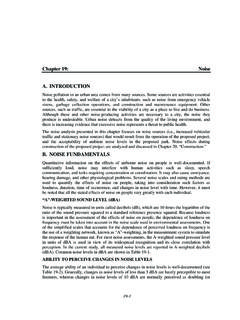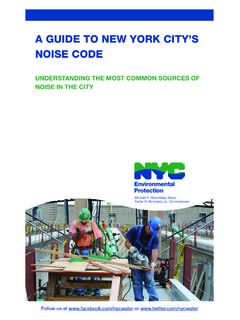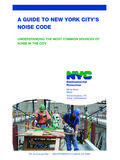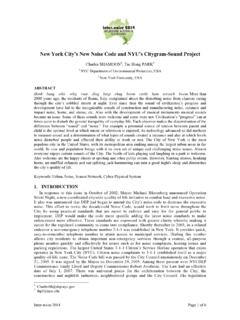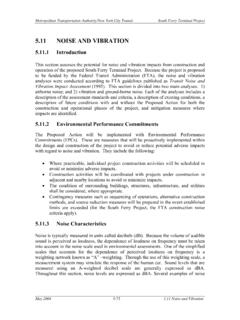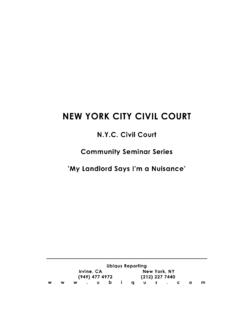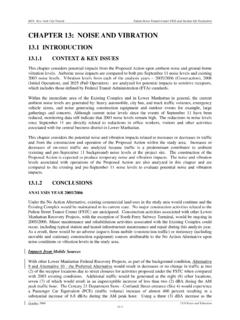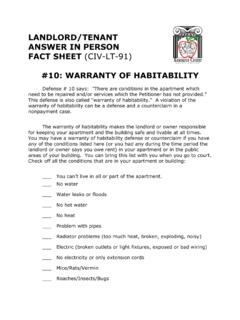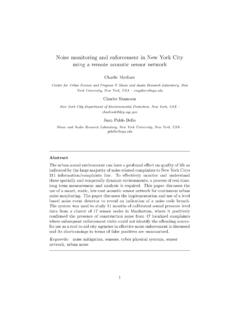Transcription of Chapter 17: Noise A. INTRODUCTION - Amazon Web Services
1 17-1 Chapter 17: Noise A. INTRODUCTION The proposed project would result in the development of a major new urban waterfront park along the East River shoreline from the Manhattan Bridge to Atlantic Avenue. The proposed project would include an approximately 85-acre public park with a mix of active and passive open spaces along the waterfront as well as residential and commercial space.
2 This Noise analysis examines three issues: 1. Whether project-generated traffic would result in significant increases in Noise levels at receptor sites in the area surrounding the project site; 2. Whether Noise levels at the proposed park would comply with new york city Environmental Quality Review (CEQR) Noise criteria; and 3. What is the appropriate level of building attenuation necessary to provide acceptable interior Noise levels. Depending on location, Noise levels in the project area are due to a combination of sources: traffic on nearby streets, the Brooklyn-Queens Expressway, and the Brooklyn Bridge; traffic and trains on the Manhattan Bridge; aircraft flyovers; and boat traffic on the East River.
3 The proposed Brooklyn Bridge Park would add new traffic to nearby streets and roadways and thereby increase surrounding Noise levels. In addition, the proposed project would increase Noise as a result of boating activities associated with the park and people using the park. As described in detail below, this Noise analysis examines the cumulative effect of Noise from all of these sources on future Noise levels with the proposed project (Build condition) compared with future Noise levels without the proposed project (No Build condition). The proposed project would result in no significant off-site adverse Noise impacts.
4 In terms of on-site locations, Noise levels both with and without the proposed project would be high. They are high in the western portion of the project site, principally due to Noise generated by traffic on the Brooklyn-Queens Expressway and along the eastern portion of the project site principally due to Noise generated by vehicular traffic and trains on the Manhattan Bridge. The project site was an industrial area at the time the Brooklyn-Queens Expressway and Manhattan Bridge were built, and Noise from these facilities was not a significant concern.
5 While Noise at the proposed park would be similar to, or less than, Noise at other new york city parks which are adjacent to heavily trafficked roadways, based upon CEQR Noise criteria, ambient Noise levels would have a potentially significant Noise impact on users of the new park. On the uplands between Pier 2 and Pier 5, the proposed park incorporates hills that reduce the Noise from the Brooklyn Queens Expressway and Furman Street by 2-to-10 dBA within the park thereby providing notable Noise abatement to the park compared to existing and no-build conditions.
6 There are no additional feasible and practicable mitigation measures that can be implemented to further reduce Noise levels within the park. Buildings on-site would be designed with sufficient building attenuation measures to comply with all appropriate CEQR guidelines. Brooklyn Bridge Park FEIS 17-2 B. Noise FUNDAMENTALS A-WEIGHTED SOUND LEVEL, dBA Loudness is a subjective quantity that enables a listener to order the magnitude of different sounds on a scale from soft to loud.
7 Although the perceived loudness of a sound is based somewhat on its frequency and duration, it chiefly depends on the sound pressure level. Sound pressure level is a measure of the sound pressure at a point relative to a standard reference value; sound pressure level is always expressed in decibels (dB), which is a logarithmic quantity. Another important characteristic of sound is its frequency, or pitch. This is the rate of repetition of sound pressure oscillations as they reach our ears. Frequency is expressed in units known as hertz (abbreviated Hz and equivalent to one cycle per second).
8 Sounds heard in the environment usually consist of a range of frequencies. The distribution of sound energy as a function of frequency is termed the frequency spectrum. The human ear does not respond equally to identical Noise levels at different frequencies. Although the normal frequency range of hearing for most people extends from a low of about 20 Hz to a high of 10,000 Hz to 20,000 Hz, people are most sensitive to sounds in the voice range, between about 500 Hz to 2,000 Hz. Therefore, to correlate the amplitude of a sound with its level as perceived by people, the sound energy spectrum is adjusted, or weighted.
9 The weighting system most commonly used to correlate with people s response to Noise is A-weighting (or the A-filter ), and the resultant Noise level is called the A-weighted Noise level (dBA). A-weighting significantly de-emphasizes those parts of the frequency spectrum from a Noise source that occur at lower frequencies (below about 500 Hz) and at very high frequencies (above 10,000 Hz) where we do not hear as well. The filter has very little effect, or is nearly flat, in the middle range of frequencies between 500 and 10,000 Hz. A-weighted sound levels have been found to correlate better than other weighting networks with human perception of noisiness.
10 One of the primary reasons for this is that the A-weighting network emphasizes the frequency range where human speech occurs, and Noise in this range interferes with speech communication. Figure 17-1 shows common indoor and outdoor A-weighted sound levels and the environments or sources that produce them. EQUIVALENT SOUND LEVEL, Leq The equivalent sound level, abbreviated Leq, is a measure of the total exposure resulting from the accumulation of A-weighted sound levels over a particular period of interest for example, an hour, an 8-hour school day, nighttime, or a full 24-hour day.
